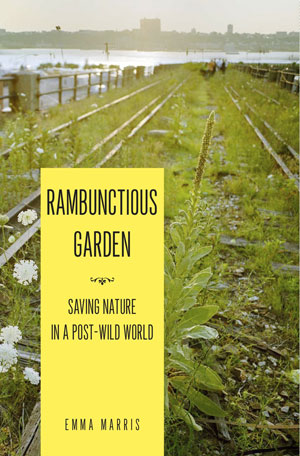What should conservation look like in the Anthropocene age? Under the premise that humans have transformed nearly the whole planet in some way, shape or form, Emma Marris challenges readers to reconsider their definitions of conservation, and proposes a paradigm shift in how humans define, perceive and understand nature to ensure success in a “post-wild world.” Marris firmly asserts that if we are to make progress on conserving nature, then the notion of pristine wilderness can no longer be the dominant narrative.
What should conservation look like in the Anthropocene age? Under the premise that humans have transformed nearly the whole planet in some way, shape or form, Emma Marris challenges readers to reconsider their definitions of conservation, and proposes a paradigm shift in how humans define, perceive and understand nature to ensure success in a “post-wild world.” Marris firmly asserts that if we are to make progress on conserving nature, then the notion of pristine wilderness can no longer be the dominant narrative.
Rambunctious Garden is both an exercise in scientific communication and a philosophical exploration of humans’ relationship with nature. While this may be Marris’ first book, she’s certainly no stranger to the topic, having spent several years covering ecology, conservation biology and other subjects for the highly esteemed journal, Nature. Marris’ experience as a journalist and formal training as a science writer are evident in her accessible writing style, one of many of the book’s strengths. Rather than being a purely abstract exploration of the human-nature relationship, the narrative is anchored by conversations with a number of individuals who are grappling with their perceptions of nature on a daily basis. Take, for example, Christian Giardina, a government ecologist based in Hawaii, who vehemently believes that historical ecosystems are superior, yet she recognizes that when you break it down to the fundamental building blocks such as chloroplasts, there isn’t really any difference between species.
Revisiting concepts like exotic species and nature-in-balance, Marris advocates for challenging long-held assumptions regarding the natural world. If we continue to hold on to the idea of nature as untouched and undisturbed by humans, it will result in continuous disappointment and keep us from engaging in the important work that can and should be done in urban areas and agricultural landscapes. This is only part of the necessary reframing; other ecological narratives associated with ideas such as invasive species must also be reconsidered.
At the same time, Marris continuously explores the need to consider the past and present realities of climate change, and how they will affect the future of conservation and restoration. She questions, for example, whether establishing ecological baselines is just a futile exercise. From a paleontological point of view, ecosystem compositions have changed drastically in any given location. However, despite the perceptual barriers that stem from dominant ecological narratives and the prospects of climate change, Marris introduces the reader to a number of innovative conservation strategies and experiments already underway in all corners of the world, from Pleistocene re-wilding to assisted migration to designer ecosystems.
It is important to note that what is considered innovative to some can be deemed questionable by others. Addressing this reality, Marris discusses both emerging and dominant ideas. She includes input from skeptics such as Dustin Rubenstein at Columbia University, who is concerned about the use of proxies for re-wilding, as well as those who straddle the boundary like Jessica Hellmann, an ecologist at Notre Dame University who researches assisted migration on Vancouver Island but is uncertain about the widespread use of such strategies. In many cases, these conversations raise some of the book’s most provocative considerations, such as the complexities of co-evolution. Yet Marris does not suggest any sort of conservation canon or panacea. Instead, she carefully considers the need to weigh the pros and cons of various conservation goals, such as genetic diversity and ecosystem services.
Overall, Rambunctious Garden offers an optimistic outlook, and it is both timely and relevant. While the Harper Government may have recently announced their intention of designating Rouge Park in Toronto as Canada’s first urban national park, the idea of pristine wilderness continues to remain at the heart of Canadian cultural and historical narratives.
Marris’ book contends that “saving nature in a post-wild world” is, and will continue to be, the work of many. That group includes ecologists and conservation biologists; policy makers and public officials; staff and board members of environmental NGOs; as well as advocates, citizen activists and volunteers.
Rambunctious Garden, Emma Marris, New York: Bloomsbury, 2011, 224 pages
Subscribe now to get more book reviews in your mailbox!
Reviewer Information
Steven M. Alexander (stevenmalexander.com) is a PhD student in the department of Environment and Resource Studies at the University of Waterloo and a member of the Environmental Change and Governance Group. His current research is focused on the governance of coastal-marine systems in the Caribbean.












